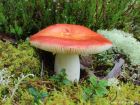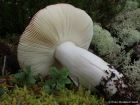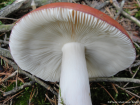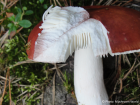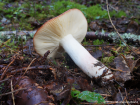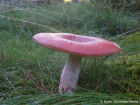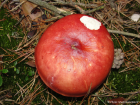Cap coloured a distinctive bloody red, pink or purple. Sometimes it may show a yellowish or orange tinge in the centre. At first convex, later flattened and depressed, shiny or somewhat sticky when damp. The cuticle can easily be peeled off halfway to the centre. The flesh is fragile, white and without scent. It quickly becomes soft and spongy and also greyish. Gills are cream or pallid ochraceous, adnexed, brittle, narrow, and strongly interveined. Stem white or tinged pink, more or less equal or tapering slightly upwards, smooth. The stem flesh is white, fragile, and stuffed. The stem has no ring. Spore print deep cream to dark ochre.
Microscopic Features: The spores are broadly ellipsoidal to globose, measuring 8-10.5 x 7-8μm. They have large warts, some up to 1.2μm tall, and are partially connected, forming a reticulate network.
Note: The mushrooms resembling Russula paludosa in North America may not necessarily be this exact species.
Russula paludosa on the www.first-nature.com web site.
Many mushrooms are poisonous, and some can be lethally toxic. Distinguishing between edible and poisonous mushrooms can be very challenging. Therefore, we strongly advise against consuming wild mushrooms. This website does not contain any information about the edibility or toxicity of mushrooms.
Although efforts have been made to ensure accuracy on this website, the information may contain errors and omissions. Therefore, all content provided is for educational and informational purposes only and should not be relied upon or used as a basis for consuming any plants or mushrooms.
External links are provided for reference only. We do not endorse or take responsibility for the content, advice, or products found on these sites or in any advertisements shown on this website.
